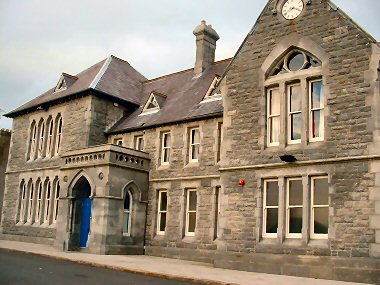Last Run on Bessbrook and Newry Tramway
One local reporter shared the last tram run to Bessbrook, as it set out from the Edward Street terminus in January 1948, with a young boy, and one man and one woman. This is his story.
In answer to his query, Mrs Hannah J Copeland replied that departure time was five thirty.
‘You mustn’t be on the tram often or you’d know the time she goes?’
‘No. I’ve never been on it before and I’m all my life in Newry’, I answered.
‘Well, you’ll never be on it again’, the man cut in, ‘For this is the last.’
He waited for a reaction. Then he continued,
‘We’re from Craigmore and she goes past the door. When she goes, we’ll have nothing.’
His wife was in the spirit for reminiscence.
‘I could cry this night. I am on this last run, and I well mind being on the first. I was a wee girl sitting on my father’s knee.’
I sought for suitable words of reassurance.
‘Sure they’ll likely give you a bus?’
‘They likely will. But they’ll have to give us a road first!’
Her husband concurred. ‘There’s forty or fifty families up in Craigmore and now we’re nowhere. Don’t know what’ll come of us.’
Two more men, John Meeks and William Barr boarded. The conductor, Tommy Anderson joined our group. Someone recognised the young chap as a Master Johnson. Of the newcomers, Davy Burns was the most expansive.
‘Ah mind when the fare to Newry was only tuppence. That was before the Bessbrook ones all wore boots!’ he added, enigmatically.
‘There was good craic on the final tram from Newry at night. Everybody talking. If you opened yer mouth too wide you might get a clout of a half-pint bottle! If you complained of thirst, you might get offered an acid drop. The morning tram was even noisier. Full of girls going to the mill, and them all singing as like as not.’
He was enjoying himself.
They’d ask if you liked it.
‘You’re not good,’ I’d say, ‘but give us another verse anyway’.
Off they’d go, laughing and singing. Them was good times but now they’re gone. There’ll be no fun like that on the buses.’
The lights dimmed, indicating that the car was slowing to a stop.
‘End of the line’, the Conductor called to the Copelands. Was it said with irony, I wondered. Goodbyes and good lucks were exchanged. They had petitioned the Directors of the Mill for a reprieve but with little optimism.
At Millvale along the line, our last passenger, bar myself, Jack Cowan got off.
Tommy Anderson told me the story of the two Brook men one time approaching the tram.
‘Are you going on the tram?’ asked the first.
‘No’, replied the other, one Willie Bradley. ‘I’m in a hurry today. I’ll walk it!’
At the terminus, the foreman concurred.
‘It’s sad but it had to happen. She’s too slow,’ he added.
Sheltering from the icy wind, awaiting the return tram to Newry, I had time to reflect on the Bessbrook/Newry tram’s history. It had opened with a flourish just sixty three years before in September 1885 and only two years after the Irish Tramways Act that enabled its construction. Its primary purpose was the conduct to Newry Port of the products of the Bessbrook Spinning Mill and the carriage of raw materials in the opposite direction. Michael Faraday had only recently made his great electrical discoveries. It was less than four years since the world had had its first electric tramway. Electric traction with the third rail system was developed by Siemens and Halske and shown at the Berlin Exhibition of 1879.
It was expected the Bessbrook tram would haul 28,000 tons of product a year. An ingenious innovation was incorporated in the local system, the flangeless wheel and shoulder rail construction of Mr Henry Barcroft of the Glen in Newry. This enabled the wagons to be used on the rail or on road, as desired. This was a unique world development. Another advantage was the ability to carry passengers too. At its maximum the driving car carried a load of 56 tons and thirty four passengers at a speed of 12 m.p.h. A 56 H.P. turbine made at Belfast fed the two dynamos via the mid-rail system. Yet at all road crossings, primarily for safety reasons, an overhead wire was substituted for the rail conductor.
My reverie was interrupted by the conversation buzz arising from the queue at the corner of the Square, awaiting transport to Newry. This was a different crowd entirely from that whose camaraderie and bonhomie I had so recently shared. Modern youth, self-possessed and self-assured, dressed in nylon macs and slouch hats with fur-lined bootees, not the peaked caps, and shawls and aprons of my recent companions. There were boys with girlfriends, a soldier going back from leave, and a gang of nippers, long-trousered and becapped, movie bound to Newry. Up at the front, girls joked with the Conductor, and from the rear floated the strains of the current croon sensation – ‘How are things in Gloccamara?’ – not liltingly as Davy Burns might recall, but ‘swooningly crooned’ – you know what I mean!
And so I ended my journey on the last tram to Newry. The Brook ones would tell you it was the longest tram in the world, because the track looped at both termini. My lasting impression was sympathy with Willie Bradley’s complaint – maybe it was ‘too slow’.
All that’s left is the occasional patch of overgrown track, such as up Derrybeg lane or to the back of Clonmore on the Armagh Road.
Such is progress.
